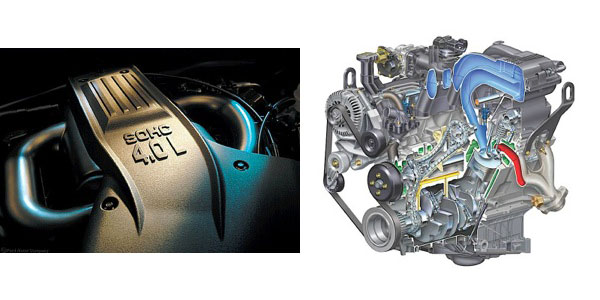Exploring the Service Needs of the Ford 4.0L V6 Engine
The 4.0l SOHC engine was found under the hood of many Ford SUVs and light trucks, as well as 2005-10 Mustangs.

Scan Tool Diagnostics And Your Shop’s Needs
A scan tool is absolutely essential for diagnostics on today’s vehicles. You need a scan tool not only for diagnosing engine, emissions and transmission problems, but also for troubleshooting virtually any system that has electronic controls. You might acquire one or two factory scan tools for the makes you service most often, but you’ll also need some type of general-purpose aftermarket scan tool that can handle a broad range of vehicle makes.
TPMS Diagnostic Strategies For Solving Errors
The first step in any diagnostic strategy is to figure out whether or not your customer’s vehicle actually has a TPMS problem. Any number of things can cause the TPMS warning light to come on or flash. The light should illuminate when a tire is low, and should eventually go out after the low tire has been inflated to its recommended pressure. If the light remains on after checking/inflating the tires, or if it flashes and remains illuminated, it may signal a TPMS problem that will require further diagnosis.
CHASSIS & ALIGNMENT: SAI DIAGNOSTICS
The Steering Axis Inclination (SAI) angle has a direct effect on steering and handling because it causes the wheel spindle to angle downward slightly as the wheel is steered. Caster, which is the forward or rearward tilt of the steering axis as viewed from the side, does the same thing. The combination of SAI and
New Aftermarket Automotive Belts and Hoses Last Longer
The original equipment belts and hoses on today’s late-model vehicles are mostly made of EPDM (ethylene propylene diene monomer), a synthetic rubber that is far more durable, heat-resistant and wear-resistant than Neoprene.
Tech Talk – Engine Innovations to Reach Government Fuel Standards
In recent years, the primary driving force behind engine innovation has been the never-ending quest for better fuel economy with little or no sacrifice in performance. Government regulations and rising fuel prices are forcing automakers to develop new technologies and powertrains that squeeze more power out of every drop of fuel while producing less pollution and greenhouse gas (carbon dioxide) emissions.
A 360° Look Into the GM 60° 3.1L Engine
Over the years, GM has saved a bundle on manufacturing the 3.1L engine by using the production line tooling it originally developed for the 2.8L V6. By simply changing the bore diameter, the displacement of the same engine block could now be increased for more power and torque.
Honda Civic Hybrid Service
Technical Editor Larry Carley discusses servicing the Honda Civic Hybrid, now in its third generation, with more than 200,000 cars sold to date since its introduction to the U.S. market in 2002 as a model year 2003, and highlights repair opportunities in diagnosing battery problems and various maintenance items.
Diagnosing Faulty Spark Plug Wires
Ignition systems have changed a great deal in recent years, with coil-on-plug (COP) ignition systems being the most common setup on many late-model engines. COP ignition systems have a single coil for each spark plug mounted on top of the plug. This setup eliminates the need for a spark plug wire and the troubles it can cause. Most other distributorless ignition systems (DIS) still have plug wires, as do older vehicles with distributors.
Suspension Tech: Monotube Shocks and Struts
When the monotube design was invented back in the 1950s, it was a revolutionary breakthrough in shock absorber technology. The floating piston and high pressure gas charge solved the foaming problem that had plagued conventional hydraulic shocks for a long time.
Clean Diesel Surge Offers Diagnostic and Repair Opportunities for the Aftermarket
There’s a bright future for the latest generation of clean diesel cars and trucks, thanks to common rail high-pressure, direct-injection systems with sophisticated electronic controls that have transformed today’s diesels into clean-running, quiet and powerful power plants. As these vehicles come out of warranty, it will create new diagnostic and repair opportunities for the aftermarket.
Tech Feature: Troubleshooting Internal Errors – Solving Piston and Ring Breakdowns
Rings that do not seal well during all four phases of the four-cycle combustion process can reduce an engine’s power potential by 20, 30, 40 or more horsepower, depending on the engine’s displacement, compression ratio and speed. Rings that leak during the intake stroke will reduce air velocity and volumetric efficiency.
